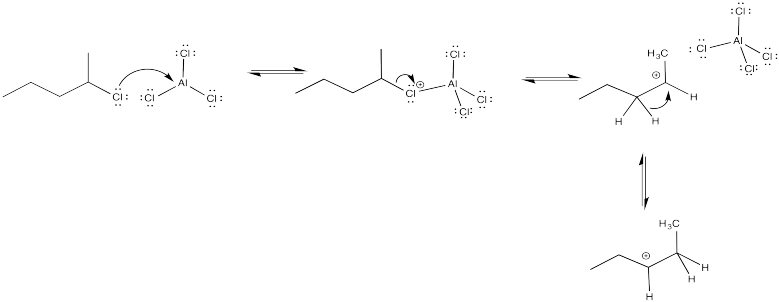7.3: Formation of the Electrophile
- Page ID
- 189876
The mechanism of electrophilic aromatic substitution follows two elementary steps. First, donation of a pair of π electrons to the electrophile results in a loss of aromaticity and formation of a cation. Second, removal of a proton from that cation restores aromaticity.
How does the electrophile form in the first place? The details of that part of the reaction vary from case to case. With the catalysed bromine reaction, the Lewis acid activates the halogen to render it more electrophilic. The activation may even go so far as to form a bromine cation, as suggested earlier. Otherwise, the positive charge on the bromine atom that ligates the Lewis acid can be nullified, indirectly, when the arene donates to the terminal bromine atom.

The appearance of a bromide ion to deprotonate the cation simply results fom the equilibrium of the Lewis acid-base complex.

Show the mechanism for chlorination of benzene in the presence of ferric chloride.
The reactions of alkyl and acyl halides also involve Lewis acid catalysts; frequently, aluminum chloride (AlCl3) is employed. These two reactions are called Friedel-Crafts reactions after the French and American co-discoverers of the reaction. Typically, Friedel-Crafts reactions are believed to occur through initial formation of cationic electrophiles, which then react with aromatics in the same way as halogen electrophiles.

The alkyl cation is a potent electrophile. It is able to temporarily disrupt the aromaticity of the aromatic ring, forming an arenium ion.

The arenium ion intermediate is probably deprotonated by halide ion; some amount of these ions would be in equilibrium with the Lewis acid-base adduct.

Because Friedel-Crafts alkylations occur via alkyl cations, the reactions of primary alkyl halides are generally pretty slow. Those cations just aren't stable enough to form. Although it sometimes seems like formation of a stable intermediate would slow things down, because it would not be motivasted to react further, usually the reverse is true. Because an intermediate is at high energy, it is inherently difficult to form in the first place. This difficulty acts as a blockade on the reaction, so that it doesn't proceed very easily.

Forming the intermediate more easily, therefore, allows the reaction to proceed more quickly. For example, the tert-butyl cation is relatively stable, so that intermediate is formed relatively easily. Alkylation of aromatics rings with tertiary alkyl halides is especially easy to accomplish.

In some cases, formation of a cation probably does not happen at all. Instead, the activated Lewis acid-base complex acts as the electrophile directly. This pathway seems to occur with methyl electrophiles. However, there are also indications that primary alkyl halides undergo this mechanism in parallel with the cationic mechanism.

It is worth noting that in some cases, multiple products may result via rearrangements. These observations provide additional evidence for the cationic nature of the intermediates as well as competing pathways.
Show the mechanism for the Friedel-Crafts alkylation of benzene with 2-chloropropane in the presence of aluminum chloride.
- Answer
-

Why is the Friedel-Crafts reaction of 1-chloropropane so much slower than the reaction of 2-chloropropane? Explain using a mechanism and intermediates.
- Answer
-
The primary cation formed is very unstable. As a result, there is a high barrier to cation formation.

Show why Friedel-Crafts alkylation of benzene with 2-chloropentane results in the formation of two different products.
- Answer
-

Show the mechanism for the Friedel-Crafts acylation of benzene with ethanoyl chloride (acetyl chloride) in the presence of aluminum chloride.
- Answer
-

Show why the Friedel-Crafts acylation of benzene with pentanoyl chloride results in only one product, with no rearrangement.
- Answer
-

The cation that results is stabilized via π-donation from oxygen.
Nitration and sulfonation reactions differ from the other substitutions that we have seen because they do not utilize Lewis acid catalysis. These reactions depend on equilibria that occur in strongly acidic media. When nitric acid is dissolved in sulfuric acid, there is spectroscopic evidence than NO2+ forms, providing an electrophile. That electrophile adds readily to the aromatic ring.

Similarly, when sulfuric acid is concentrated by boiling off residual water, sulfur trioxide results. Under these acidic conditions, the latter easily forms SO3H+, the electrophile in sulfonation.

Provide a mechanism for the formation of NO2+ from nitric and sulfuric acid.
- Answer
-

Provide a mechanism for the formation of SO3H+ from sulfuric acid.
- Answer
-



